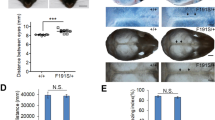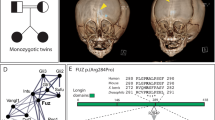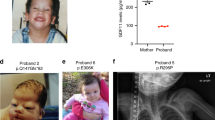Abstract
Saethre-Chotzen syndrome is one of the most common autosomal dominant disorders of craniosynostosis in humans and is characterized by craniofacial and limb anomalies. The locus for Saethre-Chotzen syndrome maps to chromosome 7p21–p22. We have evaluated TWIST, a basic helix–loop–helix transcription factor, as a candidate gene for this condition because its expression pattern and mutant phenotypes in Drosophila and mouse are consistent with the Saethre-Chotzen phenotype. We mapped TWIST to human chromosome 7p21–p22 and mutational analysis reveals nonsense, missense, insertion and deletion mutations in patients. These mutations occur within the basic DNA binding, helix I and loop domains, or result in premature termination of the protein. Studies in Drosophila indicate that twist may affect the transcription of fibroblast growth factor receptors (FGFRs), another gene family implicated in human craniosynostosis. The emerging cascade of molecular components involved in craniofacial and limb development now includes TWIST, which may function as an upstream regulator of FGFRs.
This is a preview of subscription content, access via your institution
Access options
Subscribe to this journal
Receive 12 print issues and online access
$209.00 per year
only $17.42 per issue
Buy this article
- Purchase on Springer Link
- Instant access to full article PDF
Prices may be subject to local taxes which are calculated during checkout
Similar content being viewed by others
References
Saethre, H. Ein Eitrag zum Turmschadelproblem(Pathogenese, Erbuchkeit und Symptomologie).DtschZNervenheilkd 117, 533–555 (1931).
Chotzen, F. Eine eigenartige familiare Entwicklungsstorung (Akrocephalosyndaktylie, Dysostosis craniofacialis und Hypertelorismus). MonatschrKinderheilkdSS, 97–122 (1932).
Cohen, M.M. Jr., Craniosynostosis: diagnosis, evaluation, and management 467–471 (Raven, New York, 1986).
Gorlin, R.J., Cohen, M.M., & Levin, L.S. Syndromes of the Head and Neck, Syndromes with Craniosynostosis: General Aspects and Well-Known Syndromes, Edn. 3, 799 (Oxford University Press, 1990).
Brueton, L.A., van Herwerden, L, Chotai, K.A . & Winter, R.M. The mapping of a gene for Craniosynostosis: evidence for linkage of the Saethre-Chotzen syndrome to distal chromosome 7p. L Med. Genet. 29, 681–685 (1992).
Lewanda, A. et al. Genetic heterogeneity among Craniosynostosis syndromes: mapping the Saethre-Chotzen syndrome locus between D7S513 and D7S516 and exclusion of Jackson-Weiss and Crouzon syndrome loci from 7p. Genomics 19, 115–119 (1994).
van Herwerden, L. et al. van Herwerden, L. Evidence for locus heterogeneity in acrocephalosyndactyly: a refined localization for the Saethre-Chotzen syndrome locus on distal chromosome 7p and exclusion of Jackson-Weiss syndrome from Craniosynostosis loci on 7p and 5q. Am. J. Hum. Genet. 54, 669–674 (1994).
Reid, C.S. et al.. Saethre-Chotzen syndrome with familial translocation at chromosome 7p22. Am. J. Med.Genet. 47, 637–639 (1993).
Reardon, W., McManus, S.P., Summers, D. & Winter, R.M. Cytogenetic evidence that the Saethre-Chotzen syndrome gene maps to 7p21. 2. Am. J. Med. Genet. 47, 633–636 (1993).
Lewanda, A.F. et al.. Evidence that the Saethre-Chotzen syndrome locus lies between D7S664 and D7S507, by genetic analysis and detection of a microdeletion in a patient. Am. J. Hum. Genet. 55, 1195–1201 (1994).
Rose, C.S.P. . et al. Localization of the genetic locus for Saethre-Chotzen syndrome to a 6 cM region of chromosome 7 using four cases with apparently balanced translocations at 7p21.2. Hum. Mol. Genet. 3, 1405–1408 (1994).
Wilkie, A.O.M. . et al. Saethre-Chotzen syndrome associated with balanced translocations involving 7p21: three further families. J. Med. Genet. 32, 174–180 (1995).
Tsuji, K. et al. Craniosynostosis and hemizygosity for D7S135 caused by a de novo and apparently balanced t(6;7) translocation. Am. J. Med. Genet. 45, 108–110 (1994).
Murre, C. < et al. Structure and function of helix-loop-helix proteins. Biochimica et Biophysica Acta 1218, 129–135 (1994).
Thisse, B., Gorostiza-Thisse, C. & Perrin-Schmitt, F. Sequence of the twist gene and nuclear localization of its protein in endomesodermal cells of early Drosophila embryos. EMBO J. 7, 2175–2183 (1988).
Hopwood, N.D., Pluck, A. & Gurdon, J.B. Xenopus twist is expressed in response to induction in the mesoderm and the neural crest. Cell 59, 893–879 (1989).
Wolf, C. et al. The M-twist gene of Mus is expressed in subsets of mesodermal cells and is closely related to the Xenopus X-twi and the Drosophila twist genes. Dev. Biol 143, 363–373 (1991).
Wang, S.M. et al. Cloning of the human TWIST gene: Its expression is retained in adult mesodermally-derived tissues. Gene (in the press).
Goodman, B.K., Green, E.D., Lewanda, A.F., Rosengren, S. & Jabs, E.W. Molecular cytogenetic analysis of chromosome 7p anomalies and clinical correlation with Saethre-Chotzen syndrome. Am. J. Hum. Genet. 57, A114 (1995).
Krebs, I., Schelbert, A., Hudler, M., Tsuji, K. & Kunz, J. Physical mapping of the 7p15. 3–21 region and analysis of a t(6;7) patient with Craniosynostosis. Meeting on Genome Mapping and Sequencing, 140 (Cold Spring Harbor, NY, 1996).
Mattei, M.G., Stoetzel, C. & Perrin-Schmitt, F. The B-HLH protein encoding the M-twist gene is located by in situ hybridization on murine chromosome 12. Mamm. Genome 4, 127–128 (1993).
DeBry, R.W. & Seldin, M.F. Human/Mouse homology relationships. Genomics 33, 337–351 (1996).
Dubois, B.L. & Naylor, S.L. Characterization of NIGMS human/rodent somatic cell hybrid mapping panel 2 by PCR. Genomics 16, 315–319 (1993).
Von Gernet, S. et al. Craniosynostosis suggestive of Saethre-Chotzen syndrome: Clinical description of a large kindred and exclusion of candidate regions on 7p. Am. J. Med. Genet. 63, 177–184 (1996).
Voronova, A. & Baltimore, D. Mutations that disrupt DNA binding and dimer formation in the E47 helix–loop–helix protein map to distinct domains. Proc. Natl. Acad. Sci.USA 87, 4722–4726 (1990).
Steingrimsson, E. et al. Molecular basis of mouse microphthalmia (mi) mutations helps explain their development and phenotypic consequences. Nature Genet. 8, 256–263 (1994).
Tassabehji, M., Newton, V.E. & Read, A.P. Waardenburg syndrome type 2 caused by mutations in the human microphthalmia (MITF) gene. Nature Genet. 8, 251–255 (1994).
Simpson, P. Maternal-zygotic gene interactions during formation of the dorsoventral pattern in Drosophila embryos. Genetics 105, 615–632 (1983).
Stoetzel, C., Weber, B., Bourgeois, P., Bolcato-Bellemin, A.L. & Perrin-Schmitt, F. Dorso-ventral and rostro-caudal sequential expression of M-twist in the postimplantation murine embryo. Mechan. Dev. 51, 251–263 (1995).
Fuchtbauer, E.M. Expression of M-Twist during postimplantation development of the mouse. Dev. Dynamics 204, 316–322 (1995).
Murray, S.S. et al. 1993 Expression of helix–loop–helix regulatory genes during differentiation of mouse osteoblastic cells. J Bone Miner. Res. 10, 1132–1138 (1992).
Chen, Z.-F. & Behringer, R.R. twist is required in head mesenchyme for cranial neural tube morphogenesis. Genes Dev. 9, 686–699 (1995).
Reardon, W. et al. Mutations in the fibroblast growth factor receptor 2 gene cause Crouzon syndrome. Nature Genet. 8, 98–103 (1994).
Jabs, E.W. et al. Jackson-Weiss and Crouzon syndromes are allelic with mutations in fibroblast growth factor receptor 2 (erratum appears in Nature Genet. 9,451(1995)) Nature Genet. 8, 275–279 (1994).
Park, W.-J. et al. Novel FGFR2 mutations in Crouzon and Jackson-Weiss syndromes show allelic heterogeneity and phenotypic variability. Hum. Mol. Genet. 4, 1229–1233 (1995).
Shishido, E., Higashijima, S., Emori, Y. & Saigo, K., FGF-receptor homologues of Drosophila: one is expressed in mesodermal primordium in early embryos. Development 117, 751–761 (1993).
Emori, Y. & Saigo, K. Distinct expression of two Drosophila homologs of fibroblast growth factor receptors in imaginal discs. FEBS,332, 111–114 (1993).
Albertsen, H.M. et al. Construction and characterization of a yeast artificial chromosome library containing seven haploid genome equivalents. Proc. Natl. Acad. Sci. USA 87, 4256–4260 (1990).
Green, E.D. et al. A human chromosome 7 yeast artificial chromosome (YAC) resource: Construction, characterization, and screening. Genomics 25, 170–183 (1995).
Meyers, G.A., Orlow, S.A., Munro, I.R., Przylepa, K.A. & Jabs, E.W. Fibroblast growth factor receptor 3 (FGFR3) transmembrane mutation in Crouzon syndrome with acanthosis nigricans. Nature Genet. 11, 462–464 (1995).
Francke, U., Gonzalez, y., Rivera, E.L., Delgado, C.G., Ramos, M.G. Saethre-Chotzen syndrome (SCS) with additional abnormalities in a Mexican family. New Syndromes, Part B, Annu. Rev. Birth Defects, 13, 241 (1977).
Author information
Authors and Affiliations
Rights and permissions
About this article
Cite this article
Howard, T., Paznekas, W., Green, E. et al. Mutations in TWIST, a basic helix–loop–helix transcription factor, in Saethre-Chotzen syndrome. Nat Genet 15, 36–41 (1997). https://doi.org/10.1038/ng0197-36
Received:
Accepted:
Issue Date:
DOI: https://doi.org/10.1038/ng0197-36
This article is cited by
-
A multi-stem cell basis for craniosynostosis and calvarial mineralization
Nature (2023)
-
The speckle-type POZ protein (SPOP) inhibits breast cancer malignancy by destabilizing TWIST1
Cell Death Discovery (2022)
-
Craniofacial morphology and growth in Muenke syndrome, Saethre-Chotzen syndrome, and TCF12-related craniosynostosis
Clinical Oral Investigations (2022)
-
Epithelial mesenchymal transition regulator TWIST1 transcription factor stimulates glucose uptake through upregulation of GLUT1, GLUT3, and GLUT12 in vitro
In Vitro Cellular & Developmental Biology - Animal (2021)



